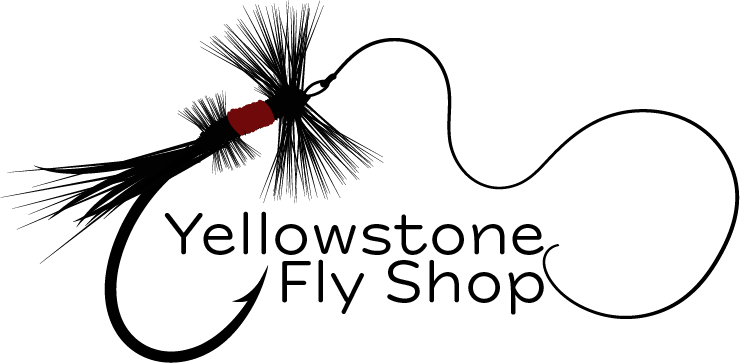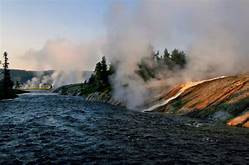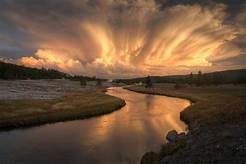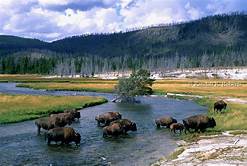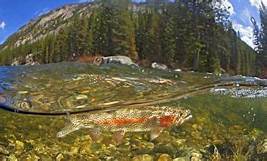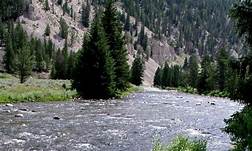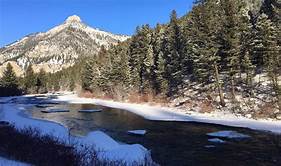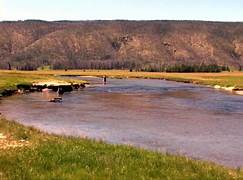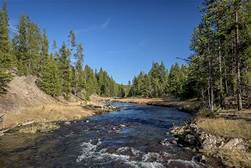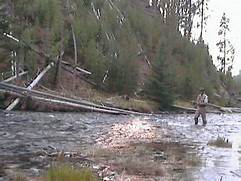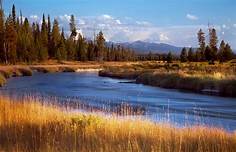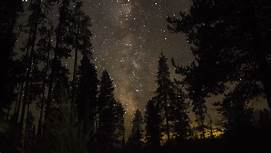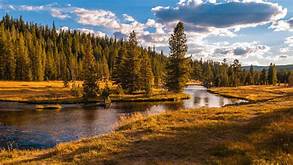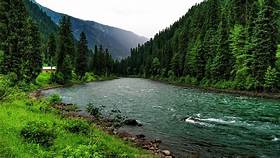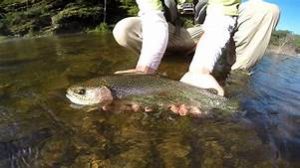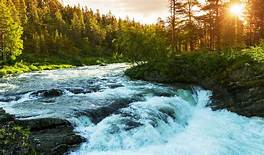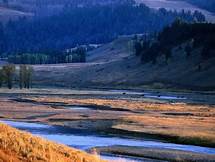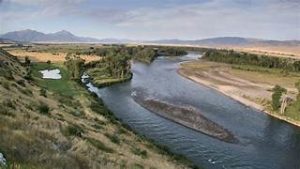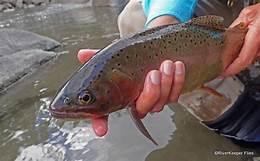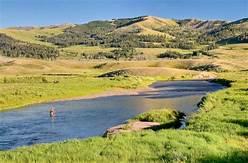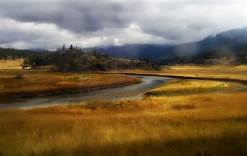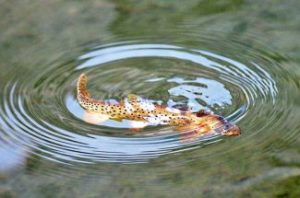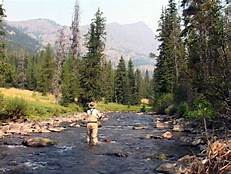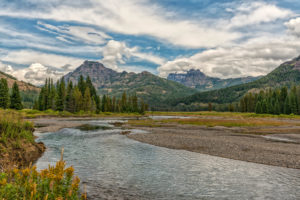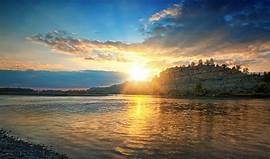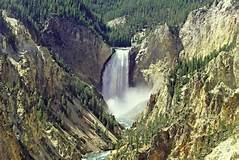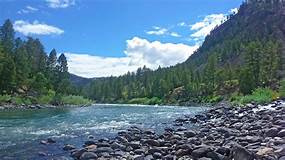Waters We Explore
Yellowstone National Park
Permit Number – CUA19-416SSF
Firehole River
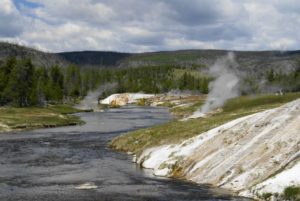
One of our absolute favorite places to fish in Yellowstone is The Firehole. Dubbed the “strangest trout stream on the planet” because it flows through three of the largest and most active geyser basins in the world before joining the Gibbon to form the Madison River. Because of this, its mineral-rich water temperatures are hotter and produce an abundance of aquatic insects, which in turn create finicky and feisty trout. Nonetheless,The Firehole is a fishing mecca and our clients get the chance to chase eager rainbow trout against a scenic back drop found nowhere else in the world.
The Firehole is legendary for its dry fly fishing during massive hatches of Baetis and Pale Morning Dun mayflies as well as several types of caddis. During the season, these trout receive a lot of fishing pressure, so it’s important to present the appropriate imitation with the proper presentation. As is the case on most “spring creeks” a quality drift, the right fly along with fine tippet will go a long way in fooling these selective trout.
With the various water temps The Firehole presents, July and August are often too warm to fish here without stressing the fish out too much. During this time, we recommend fishing other amazing waters in the park. Once the fall shoulder season arrives the water has cooled again and the Baetis hatches return to make for some incredible dry or wet fly fishing once again.
Gallatin River
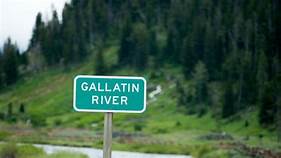
The Gallatin River located in the Northwest corner of Yellowstone National Park begins its journey from high up in the Gallatin Mountain range. The Gallatin river within YNP can be divided into two main sections. The first being the upper 12 miles from its beginning at Gallatin Lake down to where it meets Hwy 191. Please note that the first 6 miles of the Gallatin beginning at the lake is in a Bear Management area that requires NO off-trail travel or recreation.
In this first section, the river is small, much like a spring creek, as it twists its way down steep narrow valleys and occasional meadows. These waters are very clear, so a stealthy approach and accurate presentation are important if one is going to hook-up with these 10-12-inch Cutthroat and Brook trout.
Fishing pressure in this section is light as it requires a hike to reach. Do to the terrain, the fish in this section can be spread out, so don’t spend too much time in one section if you are not seeing any activity. Keep moving and searching for obvious holding water in deep pools, runs and undercut banks. A light weight rod and dry flies are the standard for fishing this section. Focus on various attractor patterns and terrestrials and you should have no problem hooking up. If solitude and lively fishing is what one is looking for, the upper Gallatin will provide it.
The lower section of the river runs for 11 miles through a beautiful valley before it leaves Yellowstone National Park and enters Montana. The valley section of the Gallatin River is the most popular for fishing as it provides the easiest access as it parallels Highway 191 the entire way. However, don’t let this scare you off as even with the easy access, there always seems to be plenty of space to offer a quiet secluded opportunity to enjoy a day of quality fishing.
This entire valley supports healthy populations of rainbow, brown, cutthroat, and some brook trout. Fish average in the 12 -14-inch range, but there is always the chance off hooking up with a real brute. The habitat here is excellent providing lots of classic riffles, runs, holes and undercut banks
Dry fly fishing on the Gallatin is amazing, beginning in July using Elk Hair Caddis, Pale Morning Duns, Green Drakes, and various attractor patterns in sizes 14-18. Terrestrial fishing is excellent using hopper imitations, sized 4-10, beginning in July and lasting through September.
Gibbon River
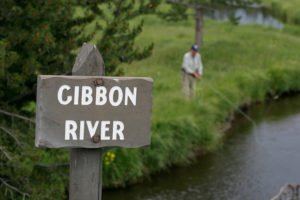
The Gibbon River starts out in Yellowstone National Park on a plateau from Grebe Lake as a small stream. It flows from there into Wolf Lake and out of it through some fairly steep gradients into Virginia Meadows. From there it flows through the Virginia Cascades into Norris Meadows. There are some small rainbows in the upper fast water sections, but the trout are mostly brook trout in the meadows.
The river meanders back and forth through Norris Meadows and then through a fast water section into Elk Park, another large meadow. This water is a combination of slow smooth sections and some fast short riffles with some nice size rainbow and brown trout.
From Elk Park it flows into Gibbons Meadows, another large smooth water section with larger trout. From there the river continues at a steeper decline for a few miles down to the Gibbon Falls.
Below the falls is a deep canyon section where the stream eventually slows down and flows into the lower Gibbon Meadows. The fish in the fast water sections are not as large as some in the upper meadows, but they are generally much easier to catch and more plentiful.
There’s an exception to the size of the fish in the lower meadows. During the early Fall, large brown trout move into the lowerGibbon to spawn. The Gibbon River flows through the lower meadows where it joins the Firehole River to form the most famous trout stream in the United States – the Madison River.
Fly fishing the Gibbon River can consist of a wide variety of fly fishing opportunities ranging for small brook trout to large brown trout. It all depends on where you fish the river. Other than the meadows, the river is primarily consist of fast flowing riffles and pocket water. There’s also a few pools mixed in making up the classic riffle, run, pool configuration.
The Gibbon is never a large stream from start to finish. If you enjoy fishing small stream, you will love fly fishing the Gibbon River.
Bechler River
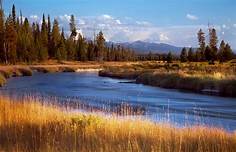
The Bechler River resides in the Southwest corner of the Yellowstone National Park and is known as the “Cascade Corner” due to the many water falls in the area. It’s created by a few small streams and during the first five miles runs through a steep, rugged canyon where its two significant cascades are found (Iris and Colonnade Falls).
After the falls, the Bechler turns into a slower-moving meadow stream that maintains a population of large rainbows and a few larger cutthroats. This is the area we love to focus on as it’s fish will challenge even the most experienced anglers. Green and Brown Drakes as well as Pale Morning Dun’s come off in late June and into July. August is peak season for hoppers, ants and beetles.
The slower moving water and high banks make it especially challenging to keep from spooking the fish, so it requires a very careful approach. Don’t be surprised if our guides as you to be on your hands and knees. We find that sight fishing and casting to individual trout is the best method. Since precise casting is required for success in the Bechler meadows, we try to limit this trip to only experienced anglers.
Fall River
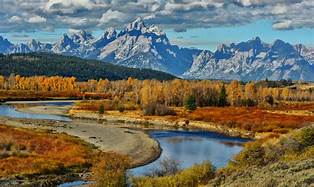
While it is listed on most maps as the “Falls River”, it’s name was officially changed to the Fall River in the mid-1980’s. Although the Fall River requires a hike to reach it within Yellowstone National Park, it’s remoteness, lack of pressure and always hungry trout make it well worth the effort.
The headwaters of the Fall River start at Beula Lake inside Yellowstone and is a mixture of meadows and canyon sections. Trout in the Fall River are mostly rainbow and cutthroat averaging 9 to 15-inches. In Terrace and Rainbow Falls (aka the canyon section), the water runs swifter and holds plenty of quality fishing. The average rate of descent is more than 50 feet/mile. These canyons are often deep and picturesque creating a memorable backdrop.
Further down river in the forested meadow, clients can expect to begin catching rainbows and cutbows in addition to the cutthroat. As expected, the river is slower moving and more difficult to fool the fish because the trout can get a good look at your fly. However, this area tends to produce the largest fish. Here, the river flows over a bed of basalt lava for about 6 miles and wading can be difficult because the rocks are slick. We ask clients to be more mindful about their footing and balance while in this section.
Remember, this is remote, get-away-from-it-all country. It’s worth slowing down to take in the scenery.
Lamar River
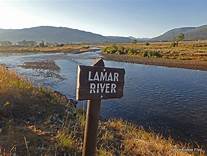
The Lamar Valley is one of the most scenic and beautiful areas in Yellowstone Park and if spotting wild life is high on your list, chances are you may spot buffalo, elk, bears, wolves, antelope, otters, osprey, bald eagles and coyotes depending on time of year. Once the fall run off has ended and the Lamar has cleared, it quickly becomes are favorite destination of our guides and clients.
In the Lamar’s upper sections, the river meanders through grassy meadows with gentle riffles, boulders, and undercut banks providing some great cover for its native Cutthroat trout.
Downstream, this river cascades into a short, narrow canyon. Although, a challenging section for some, this part of the Lamar is filled with huge boulders that create small pocket water and runs filled with eager Cutthroat and the occasional Rainbow trout. As the river leaves the canyon it veers away from the road as it races towards its meeting of the Yellowstone River. In this section far away from the highway, our clients can enjoy some solitude and excellent fishing.
In July, there are good hatches of Pale Morning Duns, Green and Gray Drakes as well as a variety of caddis making hopper fishing excellent from late July through late September. In mid-September, the Lamar continues with its production and heavy hatching of Green and Gray Drake mayflies. These are big bugs, size 10 and 12, and tend to bring up all the big fish. If you hit the right day (gray and cloud covered), you can actually find some of the best dry fly fishing of the season.
The Lamar Valley is by far a top contender as one of the most beautiful places to fish – anywhere. One caveat, the Lamar tends to get muddy from heavy rains and storms, so watching the weather is something that we monitor.
Slough Creek
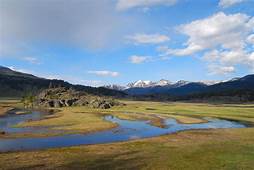
Located in the NE Corner of Yellowstone National Park and a major tributary of the Lamar River, Slough Creek is a very popular fishing destination. Accessing the river is easy and the scenery within its three major meadows is beautiful.
The first meadow located above the campground, is roughly an hour walk from the trailhead. This hike starts with a steep climb but quickly levels out to a nice gradient. This area is the most popular with anglers because of its easy access and close proximity to classic rifling meadow waters as well as nice holding water too. The fishing here is excellent, however it is a popular spot throughout the summer.
The second meadow is an additional hour hike into the backcountry, but the effort is worth it. This additional distance cuts down the number of anglers, so fishing is more solitide. This trip is recommended for those in very good shape amd enjoy hiking to limit lost fishing time vs. hiking. This trip can also be booked as an overnight outing.
The third and highest meadow within Slough Creek is only offered as an overnight backcountry option due to its distance. Note, there are reservation-only campsites in both the 2ndand 3rdmeadows, but they all fill up fast, so if this is a trip you are considering, please plan well in advance as availability is never guaranteed.
Many of the cutthroats in the second and third meadows average 18 to 20 inches -these are big, beautiful fish. Sometimes a long cast is required and/or a very stealthy approach can get you within striking distance. This can be some of the finest sight fishing you will experience in the park or almost anywhere.
Hatches of caddis, PMD’s, and large Green Drake mayflies make for some spectacular dry fly fishing in the middle of summer and as the season wears on the hungry trout begin to focus on hoppers and terrestrials.
Soda Butte Creek
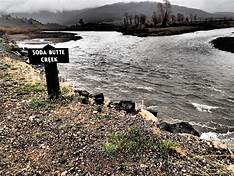
Soda Butte Creek is the main tributary streams of the Lamar River. It flows through one of the most beautiful valleys in the World offering spectacular scenery. Because of the spring runoff, the creek is generally not fishable until mid-July. Soda Butte Creek begins outside the park in Montana and flows inside the Northeast corner of Yellowstone National Park. The stream has mostly cutthroat trout but there are also a few smaller rainbows.
Upper Reaches:
The upper part of Soda Butte Creek flows into Icebox Canyon which is a deep ravine that sees little sun. Ice stays in the bottom of this canyon most of the yearhelping keep the water temperature of the stream low even during the summer months.
Within close proximity toIcebox Canyon, Soda Butte Creek picks up the water from Pebble creek, a small tributary stream.The fish are usually larger below the Pebble Creek confluence; however, the upper part of the stream is full of smaller, eager trout very willing to take your fly. The stream is very easy to access with the uppermost part of the stream starting near Cooke City just outside the Northeast entrance of Yellowstone. From there it flows along the Northeast Entrance Highway.
Lower Reaches:
The lower part of Soda Butte Creek near the Lamar River confluence, flows through vast meadows and host the largest cutthroat trout, up to 18 inches and even better, can be taken from this section.
Soda Butte Creek has a very good supply of aquatic insects that makes the fishing even more interesting. Stoneflies, caddisflies, mayflies and several types of terrestrial insects makes up the ample food supply for the trout that average 12 and 14 inches in length.
Yellowstone River
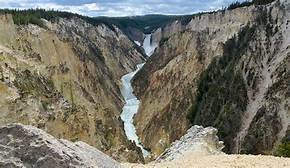
The Yellowstone River is the longest free flowing river in the lower 48 and one of North America’s “most productive wild trout fisheries”. The Yellowstone River offers two types of fishing opportunities. The first can an easy day trip spent below the falls of the Grand Canyon fishing “big” waters for beautiful native cutthroat trout. Or the second, an adventurous hike into the more remote Black Canyon.
The river in these two canyon sections is best characterized as a boulder strewn fishery loaded with 14-17” native cutthroats and a sprinkling of browns and rainbows. The dry fly fishing for the surface feeding Cutthroats can provide for a lot of action.
If you are up for the challenge, it is possible to fish some of these waters through a full-day trip with a solid hike. A better approach would be to ask us about availability of one of our overnight camping options. These canyon sections fish best from the end of runoff in late June or early July into the early fall.


